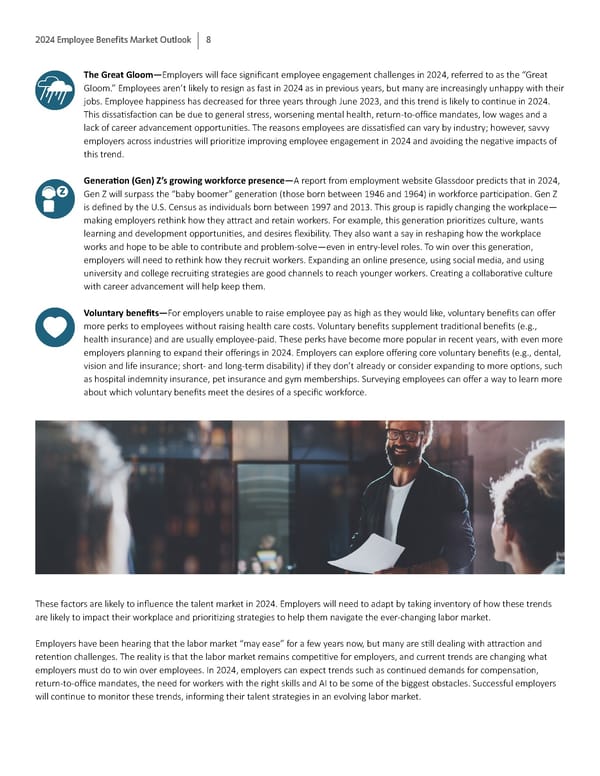2024 Employee Benefits Market Outlook 8 The Great Gloom—Employers will face signi昀椀cant employee engagement challenges in 2024, referred to as the “Great Gloom.” Employees aren’t likely to resign as fast in 2024 as in previous years, but many are increasingly unhappy with their jobs. Employee happiness has decreased for three years through June 2023, and this trend is likely to con琀椀nue in 2024. This dissa琀椀sfac琀椀on can be due to general stress, worsening mental health, return-to-o昀케ce mandates, low wages and a lack of career advancement opportuni琀椀es. The reasons employees are dissa琀椀s昀椀ed can vary by industry; however, savvy employers across industries will priori琀椀ze improving employee engagement in 2024 and avoiding the nega琀椀ve impacts of this trend. Genera琀椀on (Gen) Z’s growing workforce presence—A report from employment website Glassdoor predicts that in 2024, Z Gen Z will surpass the “baby boomer” genera琀椀on (those born between 1946 and 1964) in workforce par琀椀cipa琀椀on. Gen Z is de昀椀ned by the U.S. Census as individuals born between 1997 and 2013. This group is rapidly changing the workplace— making employers rethink how they a琀琀ract and retain workers. For example, this genera琀椀on priori琀椀zes culture, wants learning and development opportuni琀椀es, and desires 昀氀exibility. They also want a say in reshaping how the workplace works and hope to be able to contribute and problem-solve—even in entry-level roles. To win over this genera琀椀on, employers will need to rethink how they recruit workers. Expanding an online presence, using social media, and using university and college recrui琀椀ng strategies are good channels to reach younger workers. Crea琀椀ng a collabora琀椀ve culture with career advancement will help keep them. Voluntary bene昀椀ts—For employers unable to raise employee pay as high as they would like, voluntary bene昀椀ts can o昀昀er more perks to employees without raising health care costs. Voluntary bene昀椀ts supplement tradi琀椀onal bene昀椀ts (e.g., health insurance) and are usually employee-paid. These perks have become more popular in recent years, with even more employers planning to expand their o昀昀erings in 2024. Employers can explore o昀昀ering core voluntary bene昀椀ts (e.g., dental, vision and life insurance; short- and long-term disability) if they don’t already or consider expanding to more op琀椀ons, such as hospital indemnity insurance, pet insurance and gym memberships. Surveying employees can o昀昀er a way to learn more about which voluntary bene昀椀ts meet the desires of a speci昀椀c workforce. These factors are likely to in昀氀uence the talent market in 2024. Employers will need to adapt by taking inventory of how these trends are likely to impact their workplace and priori琀椀zing strategies to help them navigate the ever-changing labor market. Employers have been hearing that the labor market “may ease” for a few years now, but many are s琀椀ll dealing with a琀琀rac琀椀on and reten琀椀on challenges. The reality is that the labor market remains compe琀椀琀椀ve for employers, and current trends are changing what employers must do to win over employees. In 2024, employers can expect trends such as con琀椀nued demands for compensa琀椀on, return-to-o昀케ce mandates, the need for workers with the right skills and AI to be some of the biggest obstacles. Successful employers will con琀椀nue to monitor these trends, informing their talent strategies in an evolving labor market.
 2024 Employee Benefits Market Outlook Page 7 Page 9
2024 Employee Benefits Market Outlook Page 7 Page 9